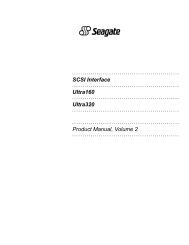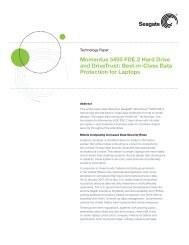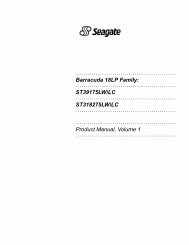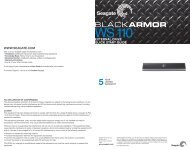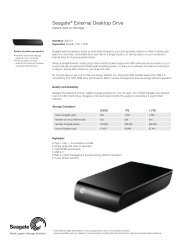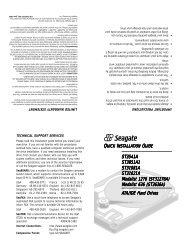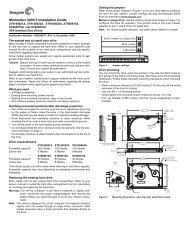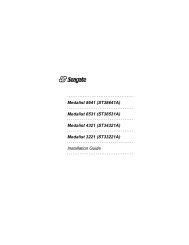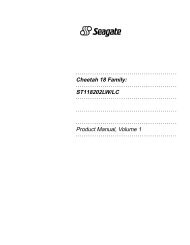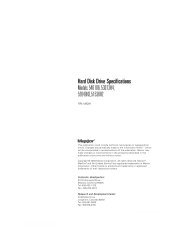Quickview 300 Product Manual PATA - Seagate
Quickview 300 Product Manual PATA - Seagate
Quickview 300 Product Manual PATA - Seagate
Create successful ePaper yourself
Turn your PDF publications into a flip-book with our unique Google optimized e-Paper software.
Glossary<br />
G<br />
GIGABYTE (GB) – One billion bytes (one<br />
thousand megabytes).<br />
GUIDE RAILS – Plastic strips attached to<br />
the sides of a disk drive mounted in an IBM<br />
AT and compatible computers so that the<br />
drive easily slides into place.<br />
H<br />
HALF HEIGHT – Term used to describe a<br />
drive that occupies half the vertical space of<br />
the original full size 5 1/4-inch drive. 1.625<br />
inches high.<br />
HARD DISK – A type of storage medium<br />
that retains data as magnetic patterns on a rigid<br />
disk, usually made of an iron oxide or alloy<br />
over a magnesium or aluminum platter.<br />
Because hard disks spin more rapidly than<br />
floppy disks, and the head flies closer to the<br />
disk, hard disks can transfer data faster and<br />
store more in the same volume.<br />
HARD ERROR – A repeatable error in disk<br />
data that persists when the disk is reread,<br />
usually caused by defects in the media surface.<br />
HEAD – The tiny electromagnetic coil and<br />
metal pole piece used to create and read back<br />
the magnetic patterns (write and read<br />
information) on the media.<br />
HIGH-CAPACITY DRIVE – By industry<br />
conventions typically a drive of 1 gigabytes or<br />
more.<br />
HIGH-LEVEL FORMATTING –<br />
Formatting performed by the operating<br />
system’s format program. Among other<br />
things, the formatting program creates the<br />
root directory and file allocation tables. See<br />
also low-level formatting.<br />
I<br />
INITIALIZE – See low level formatting.<br />
INITIATOR – A SCSI device that requests<br />
another SCSI device to perform an operation.<br />
A common example of this is a system<br />
requesting data from a drive. The system is the<br />
initiator and the drive is the target.<br />
INTERFACE – A hardware or software<br />
protocol, contained in the electronics of the<br />
disk controller and disk drive, that manages<br />
the exchange of data between the drive and<br />
computer.<br />
INTERLEAVE – The arrangement of<br />
sectors on a track. A 1:1 interleave arranges<br />
the sectors so that the next sector arrives at the<br />
read/write heads just as the computer is ready<br />
to access it. See also interleave factor.<br />
INTERLEAVE FACTOR – The number<br />
of sectors that pass beneath the read/write<br />
heads before the next numbered sector<br />
arrives. When the interleave factor is 3:1, a<br />
sector is read, two pass by, and then the next<br />
is read. It would take three revolutions of the<br />
disk to access a full track of data. Maxtor<br />
drives have an interleave of 1:1, so a full track<br />
of data can be accessed within one revolution<br />
of the disk, thus offering the highest data<br />
throughput possible.<br />
INTERNAL DRIVE – A drive mounted<br />
inside one of a computer’s drive bays (or a<br />
hard disk on a card, which is installed in one<br />
of the computer’s slots).<br />
J<br />
JUMPER – A tiny box that slips over two<br />
pins that protrude from a circuit board. When<br />
in place, the jumper connects the pins<br />
electrically. Some board manufacturers use<br />
Dual In-Line Package (DIP) switches instead<br />
of jumpers.<br />
HOME – Reference position track for<br />
re-calibration of the actuator, usually the<br />
outer track (track 0).<br />
HOST ADAPTER – A plug-in board that<br />
forms the interface between a particular type<br />
of computer system bus and the disk drive.<br />
G-4 <strong>Quickview</strong> <strong>300</strong> 80/100/120/160/200/250/<strong>300</strong>GB <strong>PATA</strong>



